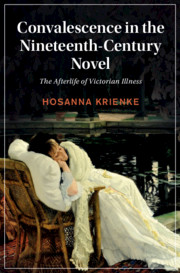Book contents
- Convalescence in the Nineteenth-Century Novel
- Cambridge Studies in Nineteenth-Century Literature and Culture
- Convalescence in the Nineteenth-Century Novel
- Copyright page
- Dedication
- Contents
- Acknowledgments
- Introduction Convalescent Time
- Chapter 1 Convalescence and the Working Class
- Chapter 2 Spiritual Convalescence
- Chapter 3 Novel Reading as Convalescence
- Chapter 4 Convalescence and Mental Illness
- Chapter 5 Imperial Convalescence
- Conclusion Convalescent Futures
- Notes
- Bibliography
- Index
- Cambridge Studies in Nineteenth-Century Literature and Culture
Chapter 5 - Imperial Convalescence
Frances Hodgson Burnett’s The Secret Garden, Convalescent Depots, and the Birth of Rehabilitation Medicine
Published online by Cambridge University Press: 24 May 2021
- Convalescence in the Nineteenth-Century Novel
- Cambridge Studies in Nineteenth-Century Literature and Culture
- Convalescence in the Nineteenth-Century Novel
- Copyright page
- Dedication
- Contents
- Acknowledgments
- Introduction Convalescent Time
- Chapter 1 Convalescence and the Working Class
- Chapter 2 Spiritual Convalescence
- Chapter 3 Novel Reading as Convalescence
- Chapter 4 Convalescence and Mental Illness
- Chapter 5 Imperial Convalescence
- Conclusion Convalescent Futures
- Notes
- Bibliography
- Index
- Cambridge Studies in Nineteenth-Century Literature and Culture
Summary
Writing from the vantage point of 1861, military historian John William Kaye analyzed the aftermath of the Indian Rebellion and its brutal suppression, surmising, “Our Indian empire is now in a convalescent state. We have come out of the perilous ordeal purged and purified; and if we are discreet in this convalescent period, we may be healthier and stronger than before.” In an effort to rationalize British soldiers’ grotesque acts of revenge following the 1857 uprising, Kaye analogized torture and murder to the characteristic irritability of convalescence. As he put it, “intense hatred and distrust of the whole race of natives” was “a natural symptom of the convalescent period, and we are not without a hope that it will soon pass away.” Alongside his hope for short-lived racial hatred, Kaye expressed his wish that the mass deployment of British troops to India would also be temporary. Again leaning on convalescence as a guiding logic, he reasoned, “unless we are to regard the present cost of our defensive establishment as temporary and exceptional, appertaining only to this transition-state – this convalescent period – we do not clearly see how we are to drag through our financial difficulties.” While Kaye’s use of convalescence as an extended metaphor for the so-called Sepoy Mutiny is distinctive, it also testifies to the vexed ways in which practices of physical rehabilitation were implicated in the imperial project, particularly in grappling with its economic and human cost.
- Type
- Chapter
- Information
- Convalescence in the Nineteenth-Century NovelThe Afterlife of Victorian Illness, pp. 122 - 148Publisher: Cambridge University PressPrint publication year: 2021

